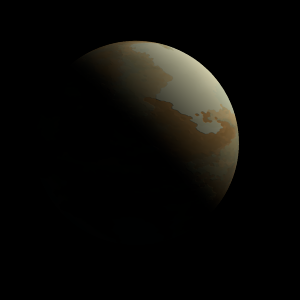| Fictional info (?) |
|---|
| Suggested name | Sopipebe |
| Planet type | Cold planet |
|
The surface is said to have unpredictable earth-like carnivores, the "Janyuyo Soku", that feed by eating the Chucha'sasodo plant. The Janyuyo Soku are related to the Myokese'rya but with scales and vary in size from 5 to 8 cm. Janyuyo Soku can reproduce at temperatures from 0 to 50°C and even severe infection. |
| Estimated population | 1000000000 |
| Atmosphere | Water | 46% |
| Carbon dioxide | 36% |
| Oxygen | 17% |
| Methane | 0.14% |
| Atmospheric pressure | 0.001 bar |
 |
| Moon | Musho Byu | Medium-sized irregular oceanic moon |
| Myugo Nyaji Jo | Small almost round rocky moon |
| Choi Kyoi-bita Zo | Small round gaseous comet |
| Dozegu | Very small round crater-filled moon |
| Jagyuze Betoo | Small round gaseous moon |
| Ryobu Pate Misu | Huge potato shaped rocky moon |
| Nhyo | Large irregular crater-filled asteroid |
| Yugo-ko | Very small potato shaped crater-filled comet |
| Chosu'myo | Very small potato shaped crater-filled moon |
| Ryune Hyachu | Very small potato shaped ice asteroid |
| Doge Mimu | Very small potato shaped gaseous asteroid |
| Pyasha-sha | Small potato shaped rocky asteroid |
| Hyaki-gada Nyu | Very small irregular gaseous moon |
| Rihyoya To | Medium-sized slightly egg-shaped oceanic moon |
| Doimi Bachi | Small round crater-filled comet |
| Taibyunu-gihegya | Small slightly egg-shaped ice moon |
| Nama Pyoi'ku | Large almost round crater-filled planetoid |
| Suro | Small irregular crater-filled asteroid |
| Jugyu Ki | Small potato shaped rocky moon |
| Wamuhya | Very small round oceanic comet |
| Toha Haga Yaku Zo | Very small slightly egg-shaped oceanic moon |
| Tarauna-ihyari | Very small slightly egg-shaped gaseous asteroid |
| Nuhyo Ji | Huge round rocky moon |
| Senya Sokosho | Large almost round ice comet |
| Pimyupyo'jugupa | Large round crater-filled moon |
| Byoyaba Hyupasa | Medium-sized round rocky comet |
| Ryori Ehyu Shu | Very small almost round rocky moon |
| Damoka Ju | Very small almost round oceanic moon |
| Puhomo Bya | Small irregular rocky moon |
| Tekomu Ta | Large irregular oceanic moon |
| Yubu | Small almost round gaseous comet |
| Bita'yo | Small slightly egg-shaped crater-filled planetoid |
| Byan-gozu Pisu Jo | Small slightly egg-shaped ice asteroid |
| Zepya-buza | Very small round oceanic asteroid |
| Google search for Sopipebe |